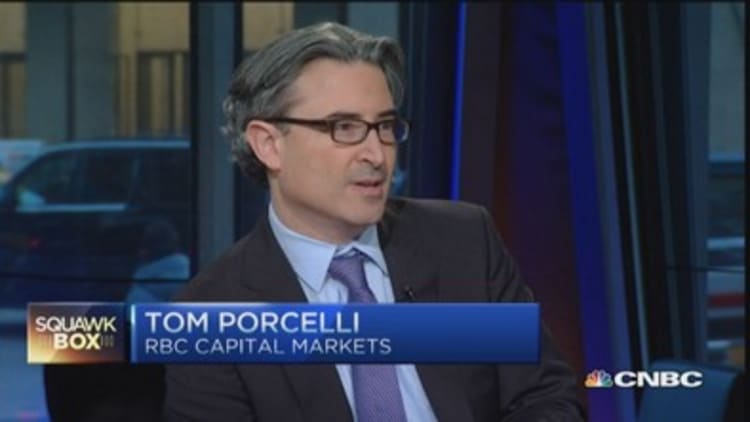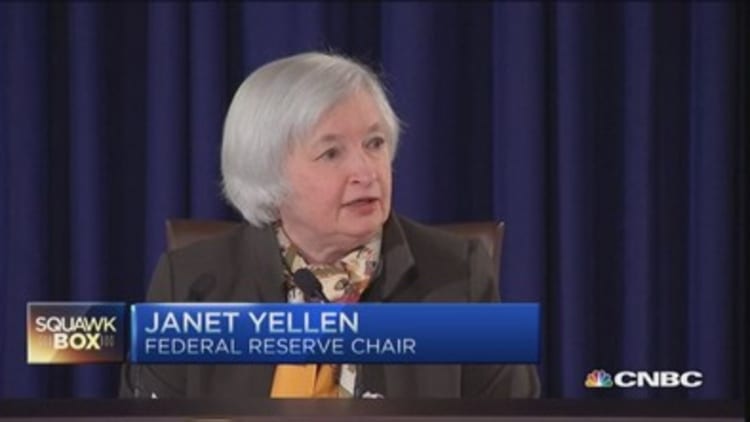


U.S. stocks closed mixed on Thursday as investors eyed options expirations and weighed the Federal Reserve statement that indicated a rate hike would come gradually.
"It's a residual effect of what (Fed Chair Janet) Yellen said yesterday," said Peter Boockvar, chief market analyst at The Lindsey Group. "People are going to debate back and forth whether she is going to raise rates."
Apple's first day as a blue chip ended in the red. (Tweet this)
The iPhone maker officially began trading as a member of the Dow Jones industrial average on Thursday, replacing AT&T in the index as Visa's 4-for-1 stock split took effect.
Of the major indices, only the Nasdaq held higher, led by Facebook to briefly touch the psychologically key 5,000 level hit on Wednesday.
Facebook closed up more than 2 percent, on pace for the stock's best weekly gain in five months. On Tuesday, the social media company announced that it will roll out a money-sending function on its Messenger app.
Read MoreTraders bet on record Facebook highs
The Dow Jones industrial average closed down more than 100 points and the S&P closed lower, giving back some of their major gains from Wednesday following dovish Fed news.
"I think you're getting power from the biotech space which is helping that (divergence)," said Robert Pavlik, chief market strategist at Boston Private Wealth. "Some of the chipmakers are seeing some interest—chips related to the automobile space."
As tech companies such as Google announce development of self-driving cars, established automakers have expressed similar intentions, or incorporate more technology into their dashboards.
The Russell 2000 edged higher to a record, extending gains from Wednesday.
Read MoreEuro-dollar parity may be more elusive after Fed
The U.S. Federal Reserve removed "patient" from its statement on Wednesday, as most analysts expected, but lowered its December rate outlook and cut economic forecasts.
"Today's investors realize that we are going to see a rate hike this year," said Alan Skrainka, chief investment officer at Cornerstone Wealth Management. He added that with Yellen shifting her tone from being "very specific to where she emphasizes data dependent, (there will be) more volatility and uncertainty in markets."
Dan Veru, chief investment officer at Palisade Capital Management, expects more mergers and acquisitions.
"The Fed looks quite disciplined here and (it) helps the economy to grow," he said. But "the shape of the recovery is so flat and so gradual that you'll see companies motivated to do deals."
The U.S. 10-year note yield held below 2 percent. The U.S. dollar recovered some of its recent losses as the euro fell to trade just above $1.06.
Crude oil futures settled down 70 cents, or 1.57 percent, at $43.96 a barrel on the New York Mercantile Exchange. Earlier, oil fell more than 3 percent after OPEC news renewed fears of oversupply. Crude gained on Wednesday following the release of the Fed statement.
"When the Fed does raise rates they're not going to be as aggressive," said Peter Cardillo, chief market economist at Rockwell Global Capital. "It's all part of a technical movement (today). A lot of people got caught on the wrong side of the Fed (yesterday)."
He noted that Thursday's session would also focus on Friday's expiration of contracts for individual stock options, stock futures, stock indexes and stock index futures, a quarterly event known as "quadruple witching."
"It really increases volatility...and tends to unwind itself come Monday as people lay on those debts again," said Art Hogan, chief market strategist at Wunderlich Securities.
The Dow has posted triple-digit gains or losses for the majority of sessions in the last few weeks, leading to an alternating pattern in this candlestick chart of the last 30-days' performance:
Volatility is also "very normal" during a "gradual change in monetary policy," said Anwiti Bahuguna, senior portfolio manager at Columbia Management. As the Fed shifts towards being "data dependent," she thinks the economy will show improvement in the second half."
Weekly jobless claims rose slightly to 291,000 for the week ended March 14. The national current account deficit sharply widened in the fourth quarter to the largest level since 2012.
The showed a modest increase in manufacturing in March but indicated the lowest level of growth in more than a year. Leading indicators rose 0.2 percent, in-line with estimates.
"Bottom line, while the headline figure was little-changed month-over-month, the overall level is best described by the Philly Fed has 'modest growth,'" Boockvar said in a note. "The bad weather is over so that can no longer be used as an excuse. The U.S. economy remains ordinary and the trend in the first quarter is particularly soft."
Tesla closed down 2.52 percent following CEO Elon Musk's announced updates to the Model S during a Thursday press conference, which included details on charging range and auto steering.
Guess surged 16 percent on better-than-expected fourth-quarter profit. Expenses fell and online sales rose.
Before the bell, Lennar posted better-than-expected quarterly profit and revenue, indicating some pickup in the housing market heading into the spring. The second-largest U.S. homebuilder by the number of homes sold said deliveries rose 20 percent in the first quarter and average selling price rose to $326,000 from $316,000.
Vince reported earnings that beat forecasts on revenue that missed. The high-end clothing firm reported fiscal fourth-quarter profit of $10.5 million.
Nike is due to report after the close.
Read MoreEarly movers: Apple, Lennar, Transocean & more
EBay was downgraded to "underweight" from "neutral" by Piper Jaffray's Gene Munster, who cited concern about impact to PayPal from payment options Google Wallet, Apple Pay, Facebook, Samsung and traditional banks. Munster also cut the price target to $49 from $55.
European equities closed mixed following the Fed's dovish comments.
Greece remains in the foreground, with Prime Minister Alexis Tsipras meeting with German Chancellor Angela Merkel in continuing debt negotiations.
Greek bond yields jumped on news that the European Central Bank was considering curbs on Greek bank purchases of government debt.
The Dow Jones Industrial Average closed down 117.16 points, or 0.65 percent, at 17,959.03, with DuPont the greatest laggard and Merck leading five blue chips higher.
The closed down 10.39 points, or 0.49 percent, at 2,089.11, with materials the greatest laggard and health care the only advancing sector.
The Nasdaq closed up 9.55 points, or 0.19 percent, at 4,992.38.
The CBOE Volatility Index (VIX), widely considered the best gauge of fear in the market, traded near 14.
Two shares advanced for every decliner on the New York Stock Exchange, with an exchange volume of 739 million and a composite volume of nearly 3.3 billion in the close.
High-frequency trading accounted for 47.5 percent of March daily trading volume, according to TABB Group. During the peak levels of high-frequency trading in 2009, about 61 percent of 9.8 billion of average daily shares traded were executed by high-frequency traders.
Read MoreWhy haven't 'Flash Boys' claims been proven?
Gold settled up $17.70 at $1,169.00 an ounce.
Major U.S. Indexes
U.S. stocks rallied sharply on Wednesday, with the Dow back above 18,000, following the dovish Fed statement.
As of Wednesday's close:
- The Dow Jones industrial average was within one standard deviation above its 50-day moving average. Since 1981 the index has been in this position 7.72 percent of all trading days, according to quantitative analytics tool Kensho. The probability of the index moving lower is 49.7 percent and the probability of it moving higher in the days following is 50.3 percent.
- The S&P 500 was within 1.5 standard deviations above its 50-day moving average. Since 1980 the index has been in this position 8.31 percent of all trading days, according to Kensho. The probability of the index moving higher in the days following is 45.1 percent and the probability of it moving lower is 54.9 percent.
- The Nasdaq composite was within 1.5 standard deviations above its 50-day moving average. Since 1980 the index has been in this position 8.26 percent of all trading days, according to Kensho. The probability of the index moving lower is 65.1 percent and the probability of it moving higher is 34.9 percent.
—Wires contributed to this report.
Correction: This story has been updated to reflect that Cornerstone's Skrainka referred to a rate hike.
Disclosure: CNBC's parent NBCUniversal is a minority investor in Kensho.
On tap this week:
Thursday
Earnings: Nike
Friday
Earnings: KB Home, Darden Restaurants, Tiffany
More From CNBC.com:


